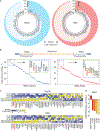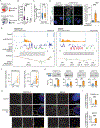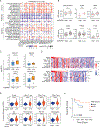hnRNPM protects against the dsRNA-mediated interferon response by repressing LINE-associated cryptic splicing
- PMID: 38815579
- PMCID: PMC11204102
- DOI: 10.1016/j.molcel.2024.05.004
hnRNPM protects against the dsRNA-mediated interferon response by repressing LINE-associated cryptic splicing
Abstract
RNA splicing is pivotal in post-transcriptional gene regulation, yet the exponential expansion of intron length in humans poses a challenge for accurate splicing. Here, we identify hnRNPM as an essential RNA-binding protein that suppresses cryptic splicing through binding to deep introns, maintaining human transcriptome integrity. Long interspersed nuclear elements (LINEs) in introns harbor numerous pseudo splice sites. hnRNPM preferentially binds at intronic LINEs to repress pseudo splice site usage for cryptic splicing. Remarkably, cryptic exons can generate long dsRNAs through base-pairing of inverted ALU transposable elements interspersed among LINEs and consequently trigger an interferon response, a well-known antiviral defense mechanism. Significantly, hnRNPM-deficient tumors show upregulated interferon-associated pathways and elevated immune cell infiltration. These findings unveil hnRNPM as a guardian of transcriptome integrity by repressing cryptic splicing and suggest that targeting hnRNPM in tumors may be used to trigger an inflammatory immune response, thereby boosting cancer surveillance.
Keywords: ALU; LINE; RNA-binding protein; cancer; cryptic splicing; double-stranded RNA; hnRNPM; interferon response.
Copyright © 2024 Elsevier Inc. All rights reserved.
Conflict of interest statement
Declaration of interests R.A.F. is a co-founder, board of directors member, and stockholder of GanNA Bio and a board of directors member and stockholder of Chronus Health. H.Y.C. is a co-founder of Accent Therapeutics, Boundless Bio, Cartography Biosciences, and Orbital Therapeutics, an advisor of 10× Genomics, Arsenal Biosciences, Chroma Medicine, and Spring Discovery, and a member of the Molecular Cell advisory board. E.L.V.N. is a co-founder, member of the board of directors, on the SAB, an equity holder, and a paid consultant for Eclipse BioInnovations, on the SAB of RNAConnect, and an inventor of intellectual property owned by University of California, San Diego. E.L.V.N.’s interests have been reviewed and approved by the Baylor College of Medicine in accordance with its conflict-of-interest policies.
Figures






Update of
-
LINE-associated cryptic splicing induces dsRNA-mediated interferon response and tumor immunity.bioRxiv [Preprint]. 2023 Feb 24:2023.02.23.529804. doi: 10.1101/2023.02.23.529804. bioRxiv. 2023. Update in: Mol Cell. 2024 Jun 6;84(11):2087-2103.e8. doi: 10.1016/j.molcel.2024.05.004. PMID: 36865202 Free PMC article. Updated. Preprint.
References
MeSH terms
Substances
Grants and funding
LinkOut - more resources
Full Text Sources
Molecular Biology Databases
Miscellaneous

